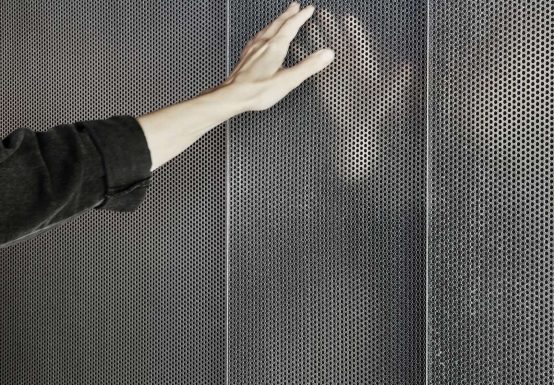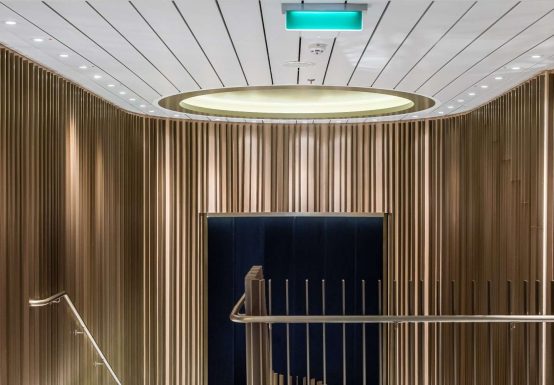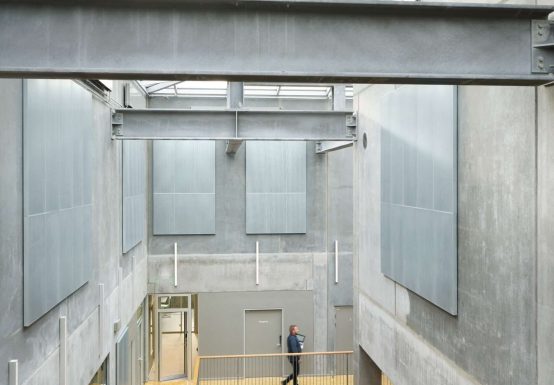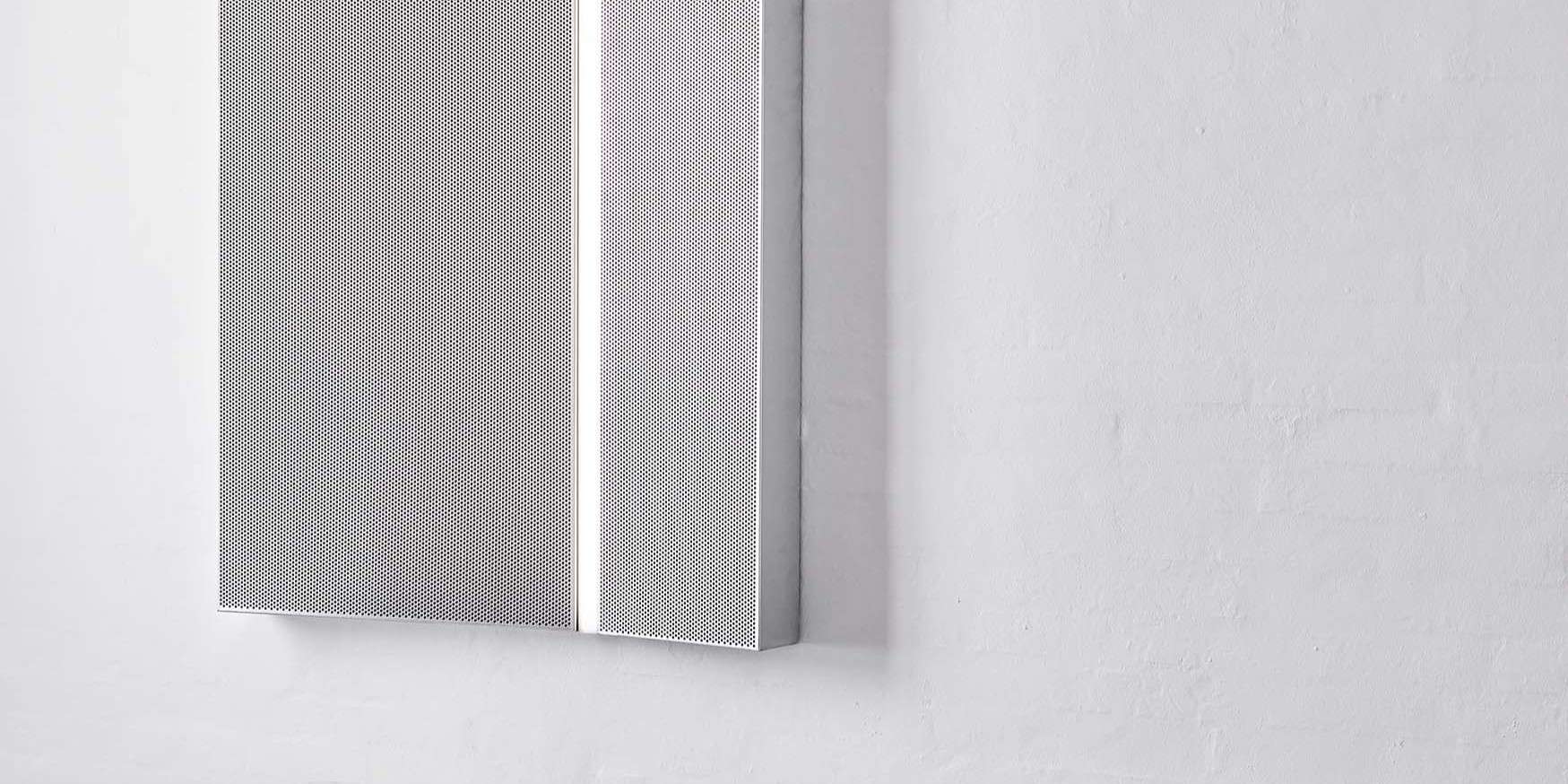Acoustics
- Acoustic solutions tailored to your specific needs
The right room acoustics is important
Noise and unwanted sound in the indoor environment makes it difficult to work efficiently. The ability to concentrate is noticeably reduced and the noise can cause stress and headaches. The negative impact of noise is particularly felt in open office environments, where studies show that even relatively low noise levels have a negative impact on efficiency and work performance.
These factors lead to a proven link between improved room acoustics, and the ability to concentrate. Extreme noise can even lead to impaired hearing or tinnitus and must be prevented.
Acoustic improvement may be to:
- Remove or isolate the sources of noise
- Reduce the noise
- Improve the interior acoustics

FAQ about acoustics
DAMPA has more than 70 years of experience with metal and acoustics. Since 1951 we have delivered millions of squaremetres of metal ceilings and acoustics solutions for both marine and building projects at home and abroad.
Beautiful architecture with curves and tailered surfaces is a DAMPA specialty. In collaboration with architects, builders and partners we create unique acoustic designs without compromising with aesthetics, functionality and visions.
Throughout the years we have heard many questions. Therefore, we have compiled the following list of frequently asked questions about acoustics.
To be concrete, acoustics expresses how sound behaves and moves in a room. Sound consists of pressure waves that travel through space. It is these pressure waves that we would like to put stop as soon as possible, so that we can achieve a pleasant acoustic environment.
Read more about what acoustics are in this article from our knowledge centre.
Acoustics are an incredibly important factor in our everyday lives, we just do not notice it unless it is bad. If the acoustics are not optimal, e.g. at the workplace or in the classroom, we become less efficient, our ability to concentrate decreases and this can ultimately be felt on the bottom line and our well-being.
Read more about acoustics and its importance in this article from our knowledge centre.
Acoustic solutions can easily be incorporated into the design of the room. With our acoustic solutions in metal, the acoustics can be included as part of the design, whether it requires a white acoustic ceiling or our Silent Board Flex, which with its interesting angles plays with light and shadow. All our acoustic solutions can be customized with colours, perforation patterns and size, so that they can become an integral part of the room's design.
Read more about the many design options here.
There are many different ways to improve poor acoustics. The most comprehensive solution is to instal a new acoustic ceiling, but this is often also the most effective.
An alternative and easy solution is adding acoustic wall panels. The rule of thumb says that in order to create an optimal acoustic experience, the walls must be covered with wall panels corresponding to 10-20% of the floor area - this figure, however, depends a lot on the interior design and purpose of the room.
Read more about how to improve the acoustics in this article from our knowledge center.
It's rare that people think of acoustics when you mention metal. But it is actually very simple why you should. By utilizing the robust surface of the metal together with the perforations, our acoustic solutions make use of all three absorbent types: the membrane absorbent, the resonant absorbent and the porous absorbent.
Read more about the different types of absorbers and the advantages of having acoustic solutions in metal here.
The answer to this must be found in the technical specifications of our products. In itself, metal is a reflective surface. However, this changes as the metal becomes thinner and thinner. Our acoustic solutions are produced from metal that is max. 1 mm thick, whereby the sound will cause the metal to vibrate rather than be reflected
Read more about acoustics and metal in this article from our knowledge centre.
You should choose an acoustic solution made of metal for three reasons:
1. As the acoustic solution is produced in metal, we activate three absorbent types: porous, membrane and resonant absorbent, this must be seen in contrast to other acoustic products, which usually only activate two absorbents.
2. The metal's robust surface offers a wealth of design possibilities. You can get an acoustic solution in the raw metallic look or painted in any desired RAL or NCS color or even have the surface digital printed, where you can get exactly the image you want.
3. Metal is a very robust meterial, ensuring a long life-span, that also makes it suitable for areas with a lot of activity. Due to the properties of the metal it is also ideeal for areas with high hygienic requirements.
All rooms have a purpose and this places different demands on the rooms and the interior in relation to the acoustics. In a classroom, the reverberation time must not exceed 0.6 seconds (cf. building regulations), but it must still be ensured that the teacher's words reach the students at the back of the room.
It is therefore important to pay attention to the use of the room, as one thing is the various legal requirements, but sometimes there is also a difference between the theoretical calculation of the acoustics and the experienced acoustics after the room has been put into use.
Read more about how to improve the acoustics and adjust it to the use of the room.
Frankly, we can not just say yes, because what is really sustainable?
However, metal is one of the raw materials that has an incredibly long life and can be reused ad infinitum. Metal is a heavy material to produce, but by recycling the metals, the amount of energy used for manufacturing can be significantly reduced by around 90%. It is therefore incredibly important that we recycle the metals so that we keep them in the circular cycle. Metal thus supports the circular economy
To ensure the transparency of our products, we have EPDs for all our ceiling solutions, both those made of aluminium, steel and our climate ceilings. In addition, we work in a targeted manner to ensure greener products and production with documentation as the cornerstone.
Read more about our work sustainability and find our EPDs here.
To ensure that our solutions work acoustically, we have established a soundproof room at our factory in Tommerup. Here we use measuring equipment from Brüel & Kjær (B&K 2250) to get an idea of the acoustic effect according to EN ISO 354 and EN ISO 11654.
In addition, we also have accredited measurements from FORCE Technology carried out.
Acoustic knowledge center
Since our foundation in 1951 we have gathered expertise and extensive knowledge about acoustics.
We know that acoustics can be a bit tricky to understand. Therefore we have gathered a ‘knowledge center’ compiled of interesting articles about acoustic related topics.
Explore the knowledge center to uncover the latest articles in the realm of acoustic knowledge that will amplify your understanding.
Get the right acoustic solution
While some may rely on generic acoustic calculators that can give an indication of the general acoustical values of the room, we recognize that each project needs a bespoke approach. Finding the most optimal solution for a project is based on many factors beyond the dimensions of the room – it depends on the interior as well as the intended use. Finding a good solution is thus not just a simple calculation. We believe, that the right solution is best found through personal dialogue.
Are you looking for acoustic solutions that go beyond the ordinary? Let our experienced team help you find perfect acoustic solution for your project.
Acoustic key-words
DAMPA has more than 70 years of experience of working with acoustic solutions and ensuring the right reverberation time. Our work has brought us wide around in the world of acoustics, where we have met a lot of interesting words and phrases.
Therefore, we would like to introduce you to our acoustic dictionary, where you can find the meaning of some of the most important words in the world of acoustics.
A material reduces the energy of sound reflected off it.
By absorbing sound energy, the volume of the reflected sound is reduced.
Within acoustic absorbers there are three main types: membrane absorber, porous absorber and resonant absorber.
The classification of sound absorbers in classes A-E (according to EN ISO 11654). The highest classification is A.

Absorption coefficient is an expression of a material's ability to absorb sound energy per square meter.
The absorption coefficient is also known by the name Alpha and the symbol α.
The absorption coefficient goes from 0 to 1, where α = 1 means that the material is 100% absorbent. If α = 0, it means that the material is 100% reflective.
To ensure a good acoustic absorbent, we use acoustic batts in our solution, which can be mineral wool, PETP or another form of porous absorbent, which we lay in our tiles and wall panels to increase the product's absorption coefficient.
Acoustic ceiling is the term for a ceiling which to one degree or another has a positive effect on the acoustics in the room.
Non-woven acoustic felt is inserted behind the metal plate and acts as a porous absorbent. In addition, the acoustic felt also functions as a design factor in our various products.
Acoustic rafts are free-hanging acoustic panels. You often see acoustic rafts hanging over the meeting table or other meeting places where extra good acoustics are needed.
Acoustics is the term surrounding sound and how sound is experienced. The word acoustics comes from the Greek words akoustikos (to hear) and akouo (to hear).
See absorption coefficient.
See soundproof room
The index describes speech intelligibility on a scale from 0 to 1. If the index is below 0.3, it is a sign of unintelligible speech, while a value above 0.7 describes good speech intelligibility.
The building regulations specify the requirements of the Building Act and contain detailed requirements that all buildings must meet.
Read more about the danish building regulations here.
DeciBell is the designation for the sound level. The decibel scale measures how loud the sound is. The decibel scale measures from 0, which is the lowest sound humans can hear. A normal conversation between colleagues is measured to be approx. 60dB. It is not recommended that you expose yourself to sound environments measured to exceed 109 dB for more than two minutes a day.
Is the random spread of sound waves around a room.
The reflective sound waves that can be heard.
The equivalent absorption area is an expression of the total area of sound absorption quantity.
To be able to calculate the equivalent absorption area, the formula A = total number of square meters of absorbents x α is used
For example: If we take 4 square meters of DAMPA Silent Board, which has an absorption coefficient of 0.95, our calculation will be the following: A = 4 x 0.95 = 3.8 m2Sab
That is, out of the four square meters of Silent Board, 3.8 m2 will be 100% absorbent.
Just as waves move in water, sound waves also move in air at a certain constant speed. The frequency is an expression of these waves and the number of peaks per second. The number of peaks is expressed in Hertz (Hz).
Expression for how much frequency a sound has.
NRC is a rating representing and overview of how much sound is absorbed by a material.
When we at DAMPA talk about the open area, it is an allusion to our perforations and how much of the metal sheet is covered by perforations and thus free access to the porous absorbent.
Perforation is a term for small holes in a thin material. In DAMPA's products, the perforations are an important player in relation to the acoustics, as they help to create resonance and the porous absorbent and at the same time they function as a design element, as we can make different sizes and patterns.
Is the persistence of a sound in a space due to many reflections after the sound source has been stopped.
Reverberation time is the time it takes in seconds for a sound to die in a room. In scientific terms, it is the time it takes for the sound level to decrease by 60 dB after the sound source is turned off.
Room acoustics is the part of acoustics that deals with how sounds such as music and speech "sound" in a room, and which properties of the room are decisive for the sound experience.
Sabine's formula was developed by the American researcher Wallace Clement Sabine (1868-1919) to calculate the reverberation time. Sabine's formula is most often used in new constructions to calculate how much absorbent material is needed. Sabine's formula calculates the reverberation time (T) by calculating the volume of the room (V) and the equivalent absorption area (A) and the proportionality factor of 0.16. Sabine's Formula looks like this: T = 0.16 x V/A
Material that can absorb ("soak up") the sound. Sound-absorbing material shortens the reverberation time and thus improves the acoustics in a room.
It is possible to make different sound measurements, which can give an insight into a room's existing reverberation time. At DAMPA we have equipment from Brüel & Kjær (B&K 2250) and we are happy to go out and do sound measurements in existing rooms if this is needed.
A soundproof room is a room where the surfaces of the room do not absorb sound but instead reflect it. Also called a reverberation chamber or reverberation chamber. A loud room is the opposite of an anechoic room. At DAMPA, we have built a soundproof room in our factory, where we can carry out our own sound measurements during the product development phase.
See index of articulation.
Square meter Sabine is the unit of measurement for the equivalent absorption area (A). Previously, the measuring unit Open Window Unit (OWU) was used, as 1 square meter open window (where the sound disappears 100% out) has the same effect as a 1 square meter Sabine.
A membrane absorber consists of a hard, thin plate that the sound of the air is able to cause to vibrate. The sound energy is thereby lost as it is absorbed by the plate.
The resonance absorber is activated in our perforations, where "air plugs" are formed that, when hit by sound waves, will carry out oscillations, where the underlying acoustic felt and cavity will act like a spring.
Wall absorbers are acoustic elements that hang on the wall.
Contact
the perfect solution for your next project.








